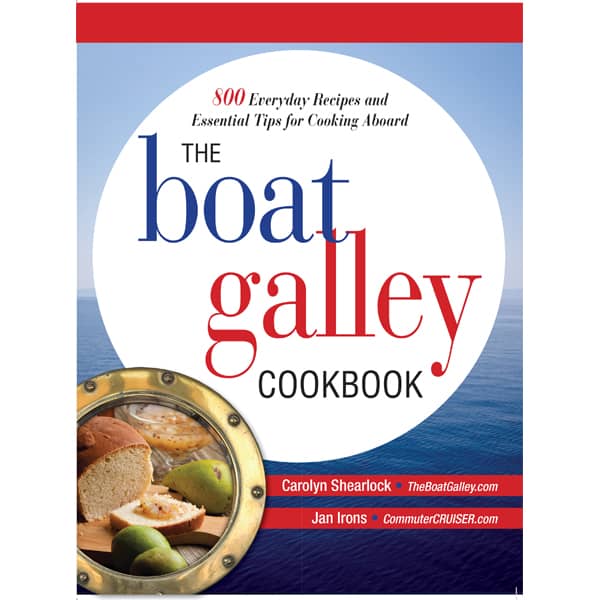If you’re not on the hard or tied up in a calm marina, your boat is pretty much always moving at least a little.
Head out sailing — especially hard on the wind as in the photo (the sea trial when we bought Que Tal) — or motoring through leftover waves and there’s more motion. Add in a squall or a tropical system and you might find the boat rolling gunwale to gunwale. Those times might be expected.
But you can also get a sudden roll in a perfectly flat anchorage as a fishing boat or jet ski comes roaring by. In other places — say the ICW or Kentucky Lake — large boats and barges with huge wakes may come almost out of nowhere to pass you by. In those cases, you’re not expecting it and there’s no time to prepare.
Most of the time, the boat itself is perfectly fine with the motion. But down below, particularly in the galley, things can get dangerous. A few precautions can make it much safer!
And yeah, there’s less motion with a catamaran . . . but it’s still not zero. Even on Barefoot Gal, I’ll follow these basic precautions.
Aboard Que Tal, Dave and I had a rule that we always anchored as if we knew it was going to blow 50 knots. Now, most of the time — maybe 99% of the time — it didn’t. And it took a little extra work every time we anchored or upped anchor. But if we did get a sudden squall, we knew we were ready. The rule paid off: on two occasions, our boat stayed put when boats anchored nearby went on the rocks.
In the galley, I had a similar rule:
Assume the boat could roll gunwale to gunwale at any time.
No, most of the time it won’t. But the little bit of extra care to keep the galley safe in case it does is well worth it when you consider the potential consequences — a serious cut from a falling knife, a broken or bruised foot from a can launched off a counter, or a nasty burn from boiling water. In six-plus years of full-time cruising, I never had a serious injury in the galley.
I developed 8 specific habits to ensure that a big roll wouldn’t result in a big injury:
- Lay knives in the sink, not on the counter, when you’re not actually using them. A dish rag or towel will keep them from banging around.
- Also put canned goods in the sink until you’re ready to use them — even a small can will injure you if it falls on your foot. Use more rags to pad them.
- Close lockers immediately after getting items out so items won’t come tumbling out. A 1/4″ lip on the shelf won’t stop a can of green beans from tumbling out if the boat rolls!
- Put things away as soon as you’re done with them — don’t leave items on the counter, where they could fall.
- Always use pot restraints and stove gimbals.
- If you’re pouring anything hot, do it in the sink — any spills or splashes will be contained and you won’t have boiling water (or whatever) down your legs.
- If possible, sit whenever you use a knife — if the boat suddenly rolls, you’re less likely to be “flung” and hence less likely to cut yourself.
- When using the oven, brace yourself well before opening the door . . . and think how opening the door may change the balance of the stove. You don’t want to fall into the oven or a lit burner on the stove top if the boat moves, nor do you want a hot pan to come sliding out of the oven the moment you open the door.
I’m sure others have additional “standard operating procedures” that lessen the chance of injury. What are yours? Add them in the comments so we can all stay safe!

Want some help with that tiny refrigerator? Check out our step-by-step how-to:












Marina. says
Thanks…every tip helps me in my learning curve.
Carolyn Shearlock says
Some days it feels like the curve is straight up, doesn’t it? How well I remember our first few trips, when it seemed like everything was new . . . and after six years I was still picking up tips from friends!
Glad you’re finding the info useful!
-Carolyn
Dave Skolnick on Auspicious says
Even cooking underway I’m a big fan of mise en place. Think through food prep and do knife work on a cutting board that lays over the gimballed cooker. You can shift the board to the side and start cooking quickly and efficiently.
The sink is a lovely repository but putting good knives in a metal sink is awful. Do all your prep, rinse and wipe the knife, steel it, and put it away.
Carolyn Shearlock says
Hi Dave!
I used a cutting board over the stove on a charter that we did, and it was great. Que Tal came with one, and I was really excited . . . but the setup was different and I never really liked it in actual use.
By the way, if you put one of your dish rags in the bottom of the sink — I fold it in half to have a double layer of fabric — the knives don’t get beaten up if it’s reasonably smooth sailing. If it’s bouncier, yep, it’s best to put them away immediately.
Nita Knighton on Facebook says
You would think most of this was common sense However, my common sense went out the ports when we moved on our boat. I can tell you all the above happened to me, the knife incident was what made me rethink safety precautions while underway . Thank You for all of your tips, what is the latest on the release of the book?
The Boat Galley on Facebook says
Hi Nita! The last we’ve been told is September 28 — we’ve just finished proofreading after the copyeditor did her thing (literally just — I sent the files back late last night) and now it goes to layout. -Carolyn
Elizabeth Aristeguieta says
The right tools definitely help!
Frances says
This article was reassuring to me……because everything you mentioned is already second nature to me. I don’t even have to think about it!
One more thing, taught to me by an experienced live-aboard cruiser:
“Always pour fore-and-aft.”
Think about it. The boat is more likely to roll than pitch, normally. If you’re aligned fore-and-aft as you pour (over the sink, of course!), you’re less likely to spill. A simple habit, now commonly executed!
sue says
We always keep a bucket in the sink that we stack things into…knives then don’t get damaged on sink.
Colin Mombourquette says
Great safety tips, thank you.
Debbie McLaughlin says
We are heading out on our first offshore trip from Ft. Lauderdale to St. Thomas so these tips are very timely advice for us. I just put some shelf liners in our cabinets to help keep our dinnerware and cookware stable and my husband (not always one for compliments!) just commented on how nice it looked. I am so happy to have found The Boat Gallery as a resource.
Carolyn Shearlock says
Have a wonderful trip!
Patty Makowski says
I usually use Corelle dishes at anchor. But I’ve found that a paper plate fits perfectly in a frisbee, and the frisbee stays on my lap, making a sandwich in the cockpit that much easier while underway.
Peg Swensen says
Hey Carolyn
We r moving onto our boat this spring & heading down the ICW in the fall. Sometime could u address two topics? #1 this may sound silly but do we call ahead to a marina to reserve a slip? And #2 how do we deal with getting medications on our way down? I have been prescribed pain medication & can only get a 30 day supply at a time. How have other people handled this? I would greatly appreciate any suggestions. Thanks!
Carolyn Shearlock says
I’ll put both your questions on the list. It pays to call ahead for marinas, particularly at busy times such as the fall migration down the ICW. I typically call marinas we’re thinking of staying at least a couple weeks in advance to see what their availability is and what their policies and so on are — unless I absolutely HAVE to, I don’t make the reservation until a day or two before I expect to be there as we never know what may happen to our “schedule!” I also try to have backups and possible anchorages in case everyone is full!
As to medicines, there are several ways to handle them: use a local pharmacy when its time to re-stock and just keep transferring from one to another (this is easiest if you use a national chain but can work even going from one chain to another). You can use a mail-order and have the meds sent to a marina that you will be at a few days after they’ll arrive (this can be hard to time and you have to check with the marina that they’ll accept packages for you — most do, but check and check that they’ll sign if a signature is needed. The third way is to have the meds sent to a mail handling service which then forwards them on to you when and where you request. Again, timing can be a pain and there is the added expense of an extra mailing. When we are on the move, we usually use local pharmacies. They typically cost a little more but the convenience is worth something — having a med shipment screwed up by not getting to a marina in time or having the meds arrive late and having to stay an extra day or two is a real hassle and potentially expensive, too.
Cyndy on El Libre says
As much as you want to use the oven for storage… don’t!
If things go a bit pear shaped while prepping or cooking and you are needed on deck, you can take everything and stick it inside the oven until you can get back to it. Or keep one prepared dish safe while you make another one and keep those sinks open.
Also, the oven is a fairly decent Faraday cage. In a squall or storm, put phones, small electronics and tablets, ipads, vhf, handheld gps, etc inside stove to protect from stray current (ie. lightening near misses). That way, if you do lose your chart plotter, vhf, whatever, you have a backup or at least a way to make that phone call to the harbormaster and possibly a way to establish your location.
(I also shudder at the thought of knives in the sink. I’m a big fan of locking blade covers. They can be washed and protect the blade in storage when things get to rattling around.)
Am I the only one that uses a safety strap in the galley? If it’s *really* nasty out, I also pull on my bibs. At least that way splatters and even a spilled boiling pot would be painful but not life threatening.
Carolyn Shearlock says
Yes, the oven is a great Faraday cage — not only do I use it, I’ve written about it. But “safety” straps, unless they are very carefully engineered/installed — can cause more injuries than they prevent: see my article on Galley Straps. For regular storage of knives, yes, locking blade covers are my preference. But as I’m cooking, and picking up/setting down the knife constantly, I do set it in the sink on a damp rag to protect it from banging.
Stephen says
thanks for your sharing, very useful. just bought a 36 Mainship, waiting for the sea trial, got to visit here oftenly.
Roger says
Obviously cutting on a replaceable cutting board is preferred to cutting on a work surface. Some guests/crew apparently need to be told. There are also a limited number of places where the cook can place hot objects.
I also suggest that pouring any liquid, especially milk, should be done over the sink. Dealing with a spill can be very time-consuming.
Surprising perhaps, I prefer quests/crew to put back equipment where they found them, so I can find them again.
I prefer cooks who wash up and clear up as they go rather than leaving it all to the end. In a seaway it also pays to do one little thing at a time (due to the limited number of hands possessed and safe places to put things).
For water conservation, especially on a small yacht, I prefer a foot pump rather than a pressurised water system. This also means that one less hand is necessary for delivering the water. So, one hand is available for self preservation.